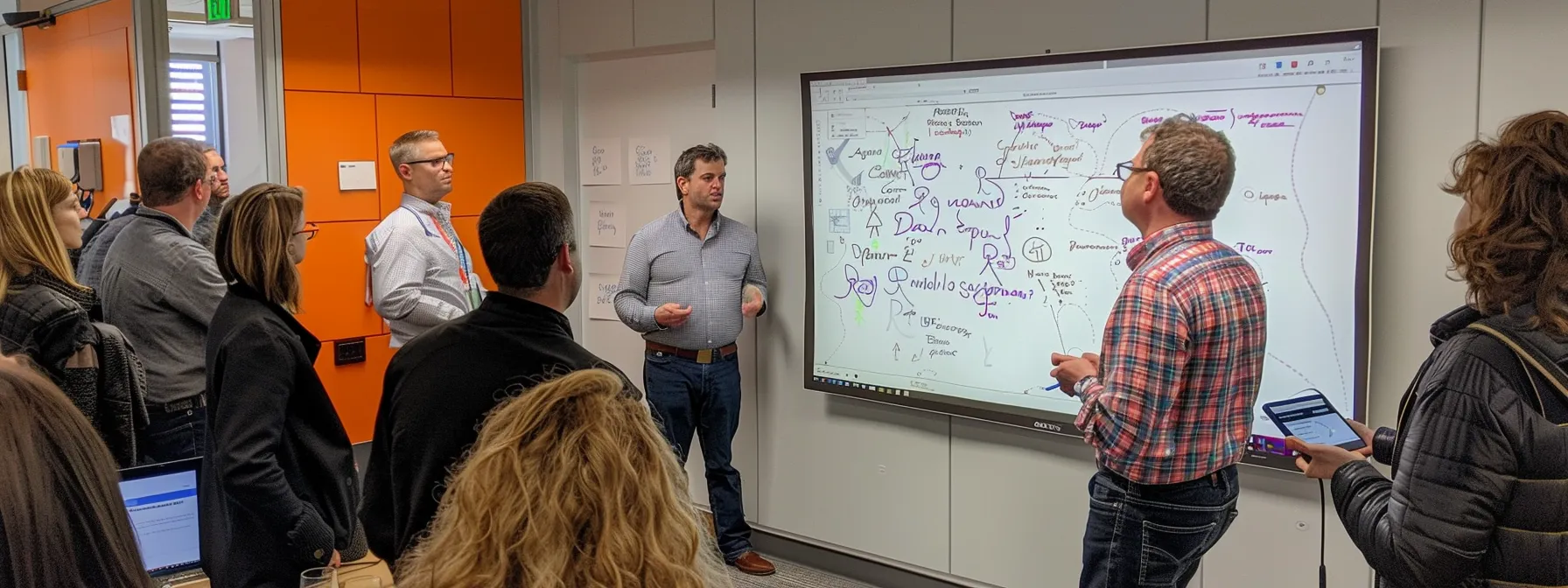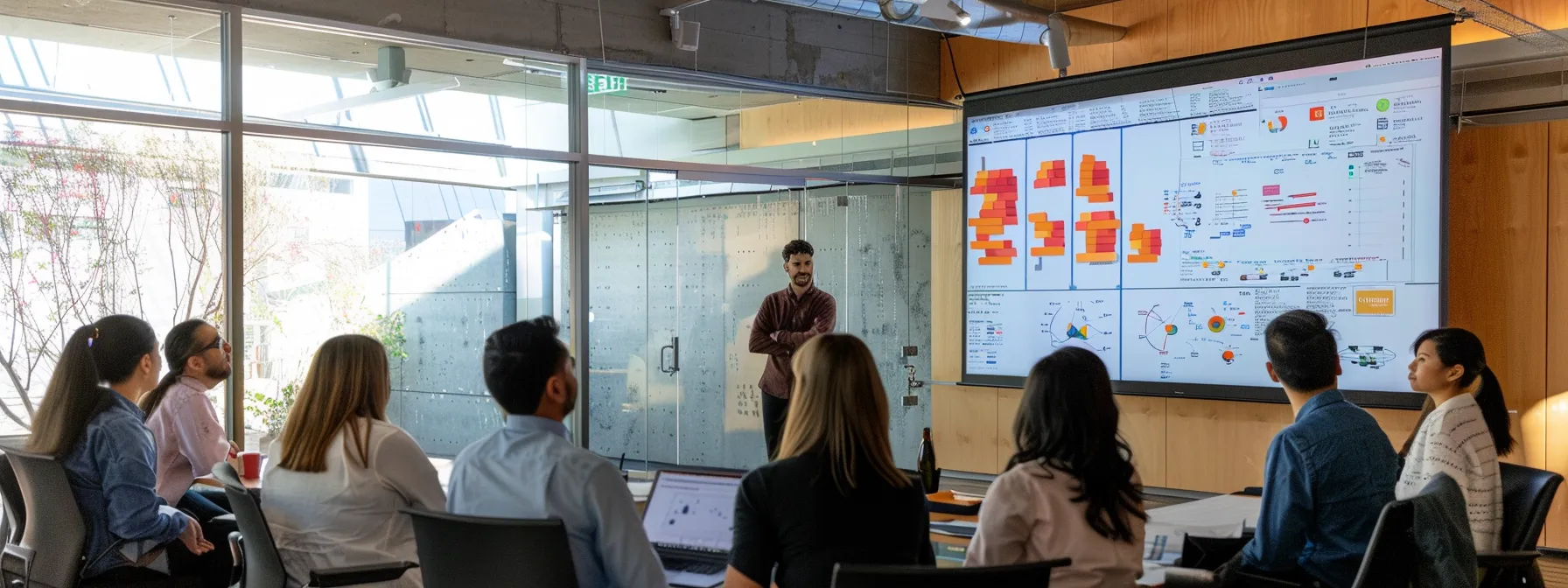Disclaimer: We sometimes use affiliate links in our content. For more information, visit our Disclaimer Page.
Leaders often face complex challenges that can hinder their organization’s progress. Research shows that effective problem-solving is crucial for success in today’s rapidly changing environment. This article will discuss strategies for developing a problem-solving mindset, highlight effective techniques, and emphasize the importance of team collaboration. By the end, readers will gain valuable insights that can enhance their analytics skills and improve their decision-making processes. This content will help leaders address the pain point of navigating tough issues, ultimately leading to better outcomes for their teams and organizations.
Key Takeaways
- Leaders must recognize and address various complex challenges to achieve organizational goals
- Encouraging open communication fosters collaboration and innovation among team members
- Employing diverse teams enhances problem-solving by bringing varied perspectives into discussions
- Balancing data-driven insights with intuition is essential for effective decision-making under pressure
- Continuous improvement through feedback and professional development strengthens leaders’ problem-solving skills
Understanding the Nature of Complex Challenges

Leaders encounter various types of complex challenges that require a firm understanding of problem-solving strategies. Recognizing these challenges is crucial, as complex problems can significantly impact organizational goals. Additionally, common obstacles in problem-solving, such as the need for effective planning and collaboration, can undermine confidence. Each subsequent section will delve into these aspects to provide leaders with practical insights for effective problem resolution.
Recognizing Different Types of Problems Leaders Face
Leaders encounter various types of problems that can hinder their workflow and affect team dynamics. These challenges may include operational inefficiencies, employee training gaps, and personal biases that impede decision-making. Recognizing these issues requires leaders to approach them with empathy and a clear mind, which can lead to more effective resolutions and foster a productive workplace environment:
Impact of Complex Problems on Organizational Goals
Complex problems can significantly disrupt organizational goals by affecting employee motivation and shaping organizational culture. When challenges arise, they may lead to negative behavior within teams, reducing collaboration and undermining productivity. Leaders can address these issues through experiential learning initiatives and effective brainstorming sessions, fostering an environment where employees feel empowered to contribute solutions and adapt to change.
Common Obstacles in Problem-Solving for Leaders
Leaders often face several common obstacles when addressing complex problems, which can hinder their efforts to foster innovation and improve efficiency. A lack of mentorship can limit the knowledge transfer necessary for effective problem-solving, as team members may not feel empowered to share insights or strategies. To overcome these challenges, leaders should prioritize creating a culture of open communication and support, where team members can collaborate freely and learn from one another, ultimately enhancing the organization’s overall strategy.
Complex challenges test the mind. To overcome them, cultivating a problem-solving mindset becomes essential.
Developing a Problem-Solving Mindset

Leaders can enhance their problem-solving capabilities by embracing challenges as opportunities for growth while cultivating resilience and adaptability. This includes encouraging a culture of open communication, which fosters critical thinking and design thinking among team members. By focusing on risk management and leveraging intuition, leaders can navigate complex problems more effectively and promote a thriving organizational environment.
Embracing Challenges as Opportunities for Growth
Embracing challenges as opportunities for growth is essential for effective leadership. Leaders who exhibit creativity and promote servant leadership can inspire their teams to engage in thinking outside the box. For instance, when faced with a significant obstacle, a leader can facilitate brainstorming sessions that encourage innovative ideas, transforming potential roadblocks into catalysts for enhanced collaboration and skill development among team members.
Cultivating Resilience and Adaptability
Cultivating resilience and adaptability is essential for leaders aiming to enhance productivity while effectively addressing challenges. famous leaders, such as Nelson Mandela and Angela Merkel, exemplify how embracing risk and adapting to changing circumstances can lead to innovative solutions. By fostering a work culture that values flexibility and open-mindedness, leaders empower their teams to face obstacles more confidently, turning challenges into opportunities for improvement and growth.
Encouraging a Culture of Open Communication
Encouraging a culture of open communication is vital for leaders aiming to solve challenging problems effectively. When team members feel safe to voice their ideas and concerns, it fosters collaboration and innovation. Leaders can facilitate this environment by regularly inviting feedback, holding open forums for discussion, and demonstrating active listening practices, thereby addressing potential issues before they escalate:
- Invite regular feedback from team members.
- Hold open forums to promote discussion and idea sharing.
- Practice active listening to acknowledge team concerns.
Leaders face obstacles that demand quick and smart decisions. Understanding effective techniques can sharpen their skills and lead to better outcomes.
Effective Problem-Solving Techniques for Leaders

Effective problem-solving techniques are essential for leaders navigating complex challenges in organizations. This section will explore key strategies such as conducting root cause analysis to identify underlying issues, brainstorming innovative solutions with team members, prioritizing actions based on their impact and urgency, implementing solutions with a strategic approach, and monitoring results to adjust strategies as necessary. Each topic provides practical insights to enhance problem-solving capabilities.
Root Cause Analysis to Identify Underlying Issues
Root cause analysis is a critical technique for leaders aiming to identify underlying issues that contribute to complex challenges. By systematically examining problems, leaders can uncover the factors that cause disruptions, allowing for targeted solutions that address the root rather than just the symptoms. For example, if a team consistently misses deadlines, conducting a root cause analysis may reveal that inadequate training or unclear expectations are at play, prompting leaders to implement effective training programs or clarify objectives:
- Conduct thorough investigations of existing problems.
- Engage team members to gather different perspectives.
- Utilize tools such as the “5 Whys” method to dig deeper into issues.
Brainstorming Innovative Solutions With Your Team
Brainstorming innovative solutions with the team is a crucial problem-solving technique that encourages collective creativity and diverse ideas. Leaders can facilitate brainstorming sessions by creating an open environment where all team members feel comfortable sharing their thoughts. By utilizing techniques like mind mapping or round-robin discussions, team members can collaboratively explore new perspectives, leading to unique and effective solutions that directly address the challenges they face:
Prioritizing Actions Based on Impact and Urgency
Prioritizing actions based on impact and urgency is a fundamental technique for leaders tackling complex issues. By assessing which tasks will most significantly influence outcomes and identifying those that require immediate attention, leaders can allocate resources more effectively. For example, addressing a critical training gap that directly affects productivity takes precedence over smaller administrative tasks, ensuring that teams remain focused on what truly drives success.
Implementing Solutions With a Strategic Approach
Implementing solutions with a strategic approach involves careful planning and execution that aligns with an organization’s broader goals. Leaders must evaluate each proposed solution’s potential impact, resource requirements, and timeline to ensure effective outcomes. For example, if a leader decides to address a customer service issue, they may implement a new training program, identify key performance indicators to measure success, and establish a timeline for evaluation, ensuring all team members understand their roles in executing the solution:
Monitoring Results and Adjusting Strategies as Needed
Monitoring results and adjusting strategies as needed is a key component of effective problem-solving for leaders. By regularly evaluating the outcomes of implemented solutions, leaders can identify what works and what doesn’t. For example, if a training program is not yielding the expected improvements in employee performance, leaders should gather feedback from participants and analyze relevant data to refine the approach, ensuring ongoing alignment with organizational goals:
Problem-solving is best when shared. Collaboration among team members can open new paths to solutions that one person might miss.
Leveraging Team Collaboration in Problem-Solving

Assembling diverse teams is crucial for gaining varied perspectives that lead to effective problem-solving. Fostering an environment of trust and psychological safety encourages open dialogue, allowing team members to express their ideas freely. Utilizing facilitation techniques helps guide discussions productively, while encouraging creative thinking and idea generation can unlock innovative solutions. Each of these aspects plays a vital role in enhancing team collaboration and addressing challenging problems effectively.
Assembling Diverse Teams for Varied Perspectives
Assembling diverse teams is essential for leaders aiming to solve complex problems effectively. By bringing together individuals with varied experiences, backgrounds, and skills, leaders can foster a rich environment for idea generation and critical thinking. This diversity enables teams to approach challenges from multiple angles, leading to innovative solutions that might not emerge within a homogeneous group:
- Diverse teams can challenge traditional thinking and drive creativity.
- Varied perspectives can highlight overlooked issues or solutions.
- A collaborative approach fosters a sense of ownership among team members.
Fostering an Environment of Trust and Psychological Safety
Fostering an environment of trust and psychological safety is essential for leaders aiming to enhance team collaboration in problem-solving. When team members feel secure to express their thoughts without fear of judgment, creativity flourishes, enabling innovative solutions to emerge. For example, leaders can promote this environment by encouraging open dialogue during meetings and actively soliciting input from all members, thus reinforcing the idea that every contribution is valued and respected.
Utilizing Facilitation Techniques to Guide Discussions
Utilizing facilitation techniques is essential for leaders aiming to guide discussions effectively during problem-solving sessions. Techniques such as setting clear objectives, encouraging participation, and managing group dynamics can help create a productive environment. For instance, a leader might use the “Fishbowl” technique, where a small group discusses an issue while others observe, allowing for diverse perspectives to emerge and enabling a balanced dialogue.
Encouraging Creative Thinking and Idea Generation
Encouraging creative thinking and idea generation is vital for teams facing complex challenges. Leaders can facilitate this process by creating an open environment where team members feel comfortable sharing diverse perspectives. Regularly incorporating brainstorming sessions and innovation workshops can help stimulate creative discussions, ultimately leading to novel solutions that enhance problem-solving and address organizational issues effectively.
Teamwork sharpens ideas but knowing when to act is what truly matters. Effective leadership hinges on clear decisions that inspire confidence and drive results.
Decision-Making Strategies for Effective Leadership

Effective leadership involves employing decision-making strategies that balance data-driven insights with intuition. Understanding the risks and benefits of each option allows leaders to make timely decisions under pressure. Clear communication of these decisions to stakeholders is crucial for maintaining trust and transparency. The following sections will explore these key components in detail, offering practical insights for leaders facing challenging problems.
Balancing Data-Driven Insights With Intuition
Effective leaders recognize the importance of balancing data-driven insights with intuition when faced with challenging problems. While data provides a foundational understanding of trends and potential outcomes, intuition informed by experience can illuminate paths not immediately obvious through analysis alone. For instance, a leader might use analytics to assess project performance but rely on their instincts gained from past experiences to guide adaptations in strategy:
- Assess data to identify patterns and inform decisions.
- Trust intuition in assessing team dynamics or market changes.
- Combine both approaches to make timely and strategic choices.
Understanding the Risks and Benefits of Each Option
Understanding the risks and benefits of each option is essential for leaders making informed decisions during complex problem-solving scenarios. Leaders should take the time to analyze potential outcomes associated with different strategies, ensuring they weigh short-term gains against long-term implications. For example, a leader faced with budget cuts must evaluate how each option affects team morale and future growth, choosing the path that supports overall organizational objectives while minimizing negative repercussions:
Making Timely Decisions Under Pressure
Making timely decisions under pressure is crucial for leaders dealing with challenging problems. Effective leaders must quickly analyze available data, assess the risks and potential outcomes, and communicate their decisions clearly to their teams. For instance, during a financial crisis, a leader might need to implement budget cuts to maintain organizational stability, balancing immediate needs with long-term goals to minimize disruption and maintain team morale.
Communicating Decisions Clearly to Stakeholders
Communicating decisions clearly to stakeholders is a key aspect of effective leadership, especially during challenging times. Leaders must articulate the rationale behind their choices, addressing potential concerns while reinforcing the overall objectives of the organization. For instance, when a significant change in strategy is implemented, leaders should hold meetings to explain the decision, offer opportunities for questions, and ensure that all stakeholders understand how the decision aligns with the company’s goals, thus fostering trust and transparency in the process.
Good leaders make choices. To grow further, they must sharpen their problem-solving skills.
Continuous Improvement of Problem-Solving Skills

Continuous improvement of problem-solving skills is essential for leaders facing challenging situations. Learning from past challenges and outcomes enables leaders to refine their strategies. Seeking feedback and mentorship fosters growth, while investing in professional development opportunities enhances skills. Additionally, staying informed about industry trends and best practices equips leaders to adapt and innovate effectively, ensuring ongoing success in overcoming complex problems.
Learning From Past Challenges and Outcomes
Learning from past challenges and outcomes is essential for leaders seeking to improve their problem-solving skills. By analyzing previous experiences, leaders can identify what worked, what didn’t, and the underlying reasons for those results. For instance, a leader who faced issues with team collaboration on a project can assess the strategies employed, gather feedback from team members, and implement changes that enhance communication and efficiency in future projects, thereby fostering a culture of continuous improvement.
Seeking Feedback and Mentorship
Seeking feedback and mentorship is a vital strategy for leaders aiming to improve their problem-solving skills. By actively engaging with mentors, leaders can gain valuable insights into their decision-making processes and identify areas for growth. For example, regular check-ins with a mentor can provide constructive criticism and alternative viewpoints, helping leaders develop a more well-rounded approach to challenges.
Investing in Professional Development Opportunities
Investing in professional development opportunities is essential for leaders seeking to enhance their problem-solving skills. Leaders can participate in workshops, conferences, or online courses that focus on critical thinking, negotiation, and team dynamics, providing them with new tools and strategies to tackle complex challenges effectively. For example, a leader enrolled in a leadership development program might learn innovative techniques for managing team conflicts, ultimately improving their ability to foster collaboration and drive organizational success:
Staying Informed About Industry Trends and Best Practices
Staying informed about industry trends and best practices is crucial for leaders striving to enhance their problem-solving skills. By regularly engaging with professional networks, attending relevant conferences, and following industry research, leaders can gain insights that inform their decision-making processes. For instance, understanding emerging technologies or shifts in market dynamics allows leaders to adapt their strategies proactively, ensuring they remain competitive and effectively address complex challenges within their organizations.
Conclusion
Effective strategies for leaders in solving challenging problems are crucial for organizational success. By recognizing various challenges, embracing a growth mindset, and fostering open communication, leaders can navigate complexities while empowering their teams. Prioritizing collaboration and continuously improving problem-solving skills further enhances decision-making abilities in dynamic environments. Ultimately, employing these strategies enables leaders to address obstacles proactively, driving innovation and fostering a resilient workplace culture.





